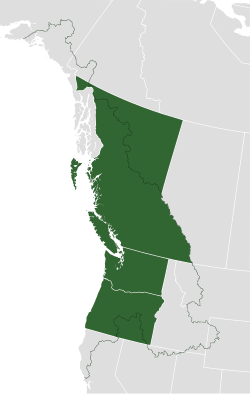Republic of the Pacific
|
Cascadia |
|
|---|---|

Boundaries of the bioregion in respect to current political territorial entities (Washington, Oregon and British Columbia).
|
|
| Capital | undecided |
| Largest city | Seattle |
| National language | Pacific Northwest English, Spanish, Cantonese, Chinook Wawa, multiple First Nations languages |
| Demonym | Cascadian |
| Area | |
|
• Total
|
1,384,588 km2 (534,592 sq mi) |
| Population | |
|
• 2016 estimate
|
16,029,520 |
|
• 2010 census
|
15,105,870 |
| GDP (PPP) | 2014 estimate |
|
• Total
|
US$825 billion estimate |
|
• Per capita
|
$53,600 estimate |
| GDP (nominal) | 2013 estimate |
|
• Per capita
|
$40,217 (2006) (8th) |
| HDI | 0.914 very high |
| Drives on the | right |
|
^ a. *Statistics are compiled from US and Canadian census records by combining information from the states of Washington, Oregon and the province of British Columbia. If the entire Cascadian bioregion was taken into account, GDP and population would be much higher. Many values use exchange rates, which may vary
|
|
Cascadia is a bioregion and proposed country located within the western region of North America. Potential boundaries differ, with some drawn along existing political state and provincial lines, and others drawn along larger ecological, cultural, political, and economic boundaries.
The country might consist of Washington, Oregon, portions of other U.S. states and British Columbia, Canada. At its maximum extent, Cascadia would stretch from coastal Southeast Alaska in the north into Northern California in the south, and inland to include parts of Idaho, Western Montana, Wyoming, and Yukon. More conservative proposed borders include the land west of the crest of Cascade Range, and the western side of British Columbia.
As measured only by the combination of present Washington, Oregon, and British Columbia statistics, Cascadia would be home to slightly more than 16 million people (16,029,520), and would have an economy generating more than US$675 billion worth of goods and services annually. This number would increase if portions of Northern California, Idaho, and Southern Alaska were also included. By land area Cascadia would be the 20th largest country in the world, with a land area of 534,572 sq mi (1,384,588 km2), placing it behind Mongolia. Its population would be similar in size to that of Ecuador, Guatemala, or Zambia.
There are several reasons why the Cascadia movement aims to foster connections and a sense of place within the Pacific Northwest region and strive towards independence. The main reasons stated by the movement include environmentalism, bioregionalism, privacy, civil liberties and freedom, increased regional integration, and local food networks and economies.
...
Wikipedia

